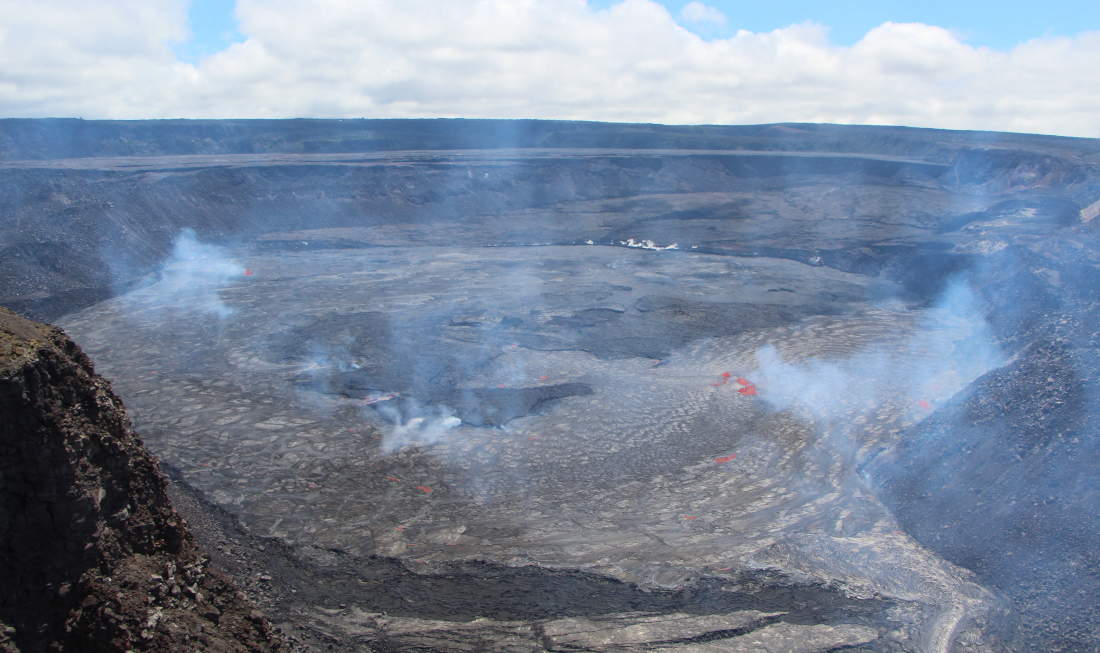
USGS: “View from the west rim of Halema‘uma‘u crater, showing the new lava flows that have covered the crater floor since the morning of June 7, 2023. This photograph, taken the morning of June 8, 2023, shows several active fissure vents that are feeding lava flows that cover the floor of the crater. These fissures have lava fountains that are throwing incandescent spatter and bombs from 5-10 m (16-33 ft) into the air. The darker middle parts of the crater floor already have solidified as cooler (but still hot) lava, whereas the lighter gray colors are primarily molten lava.” (USGS photo by D. Downs.)
(BIVN) – The eruption of Kīlauea continues, with all activity confined to the summit caldera within Hawaiʻi Volcanoes National Park.
Multiple minor lava fountains remain active on the crater floor, covering much of the western half in a broad horseshoe. The vent on the southwest wall the caldera is still feeding flows down the cliff. An active lava lake is centered within the uplifted area, and is fed by a vent its northeast corner.
Volcanic gas emissions in the eruption area are elevated, with a sulfur dioxide emission rate of approximately 8,900 tonnes per day measured, on June 10th. No unusual activity has been noted along the volcano’s rift zones.
In a recent Volcano Watch article, geologists describe the onset of this latest activity and compare it to the start of other, recent summit eruptions. The following passage was taken directly from the article written by U.S Geological Survey Hawaiian volcano Observatory scientists and Affiliates:
For days to months leading up to all eruptions at Kīlauea since 2018, as well as Mauna Loa in 2022, increased earthquake activity and ground inflation suggested that the magma storage systems below were under stress.
HVO scientists have noted these periods of “increased unrest,” and they closely monitor the data streams for signals that an eruption may be imminent. In most recent cases, the signs of an imminent eruption become evident only about an hour before the eruption occurs.
The clearest signals before these recent eruptions are rapidly occurring earthquakes—most not large enough to be felt—as rocks beneath the surface break, along with an increasing rate of inflationary ground motion as pressure builds.
These signals indicate that magma is creating a pathway towards the surface. Eventually, fountains of lava burst from the ground and a conduit is established; volcanic tremor—a signal indicating fluid movement, like the hum of water moving through a garden hose—begins to replace the earthquakes, slowly becoming the dominant signal. Ground motion then begins to deflate, indicating the release of pressure within the magma system.
An outlier is the onset of the January 2023 eruption at the summit of Kīlauea. This eruption occurred mere weeks after the previous one had ended in December 2022. Rapid earthquake activity occurred for about 30 minutes, followed by an hour of relative seismic silence before lava broke the surface with eruptive tremor. One hypothesis for why this occurred is the large amount of molten material stored beneath the surface of Halema‘uma‘u crater floor, in combination with the short timeframe following the previous eruption.
With close attention to the data on June 7, HVO scientists were able to identify the precursory activity that closely mirrored previous recent eruptions. Kīlauea’s alert level and aviation color code were elevated to WATCH/ORANGE at 3:14 a.m. HST, indicating that an eruption was imminent. HVO field staff were notified and they hurried to the crater rim; just before 4:45 a.m. HST, lava fountains illuminated webcam views and the eruption began.
The USGS alert level for the volcano remains at WATCH. The Observatory says it will continue to closely monitor Kīlauea volcano ,and issue daily updates until further notice.

by Big Island Video News8:23 am
on at
STORY SUMMARY
HAWAIʻI VOLCANOES NATIONAL PARK - The USGS alert level for the Kīlauea volcano remains at WATCH, with all activity confined to Halemaʻumaʻu at the summit.